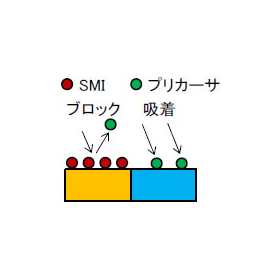UV-Vis Spectroscopy
UV-Vis is a method that measures the intensity of light transmitted through a sample by irradiating the sample with light divided by wavelength, allowing for the determination of the sample's absorbance and transmittance.
UV-Vis is a method that measures the absorbance and transmittance of a sample by irradiating the sample with light divided by wavelength and measuring the intensity of the light that has passed through the sample. By measuring absorbance, it is possible to perform qualitative and quantitative analysis of the target components in the sample, as well as evaluate the wavelength characteristics of the sample. Additionally, transmittance measurements can assess the specific transmittance characteristics of components within the sample. - It is possible to obtain absorption and transmission spectra in the ultraviolet to visible to near-infrared regions (wavelength range approximately 190 nm to approximately 3000 nm).
basic information
Spectroscopic measurement is a method to evaluate how much light comes out in response to the light irradiated on a sample (how much light the sample absorbs). Generally, there is a relationship known as the Lambert-Beer law between the intensity of the incident light I0 and the intensity of the transmitted light I.
Price information
-
Delivery Time
Applications/Examples of results
- Qualitative and quantitative analysis of components contained in solution samples - Measurement of permeability of membrane samples - Measurement of turbidity and color in environmental water - Measurement of absorption spectra of organic components - Quantitative analysis of polysaccharides - Total nitrogen analysis and total phosphorus analysis in wastewater - Analysis of functional components - Quantitative analysis of vitamin C
Detailed information
-

First, please consult with us. ★ We will start with a proposal for an analysis plan ★ Meetings at your company are, of course, possible. We will carefully explain the analysis results and leave no questions unanswered. Please contact us at 03-3749-2525 or info@mst.or.jp!
-

We will hold a visiting seminar. ★ We offer free seminars with engineers tailored to our customers' needs ★ We will introduce analysis techniques and explain analysis data according to your requests. ◆ Example seminar content - A broad explanation of MST analysis methods - A thorough and detailed explanation of specific analysis methods from the principles - An explanation of the analysis data requested by the customer Please contact us at 03-3749-2525 or info@mst.or.jp!
Recommended products
Distributors
MST is a foundation that provides contract analysis services. We possess various analytical instruments such as TEM, SIMS, and XRD to meet your analysis needs. Our knowledgeable sales representatives will propose appropriate analysis plans. We are also available for consultations at your company, of course. We have obtained ISO 9001 and ISO 27001 certifications. Please feel free to consult us for product development, identifying causes of defects, and patent investigations! MST will guide you to solutions for your "troubles"!



















































